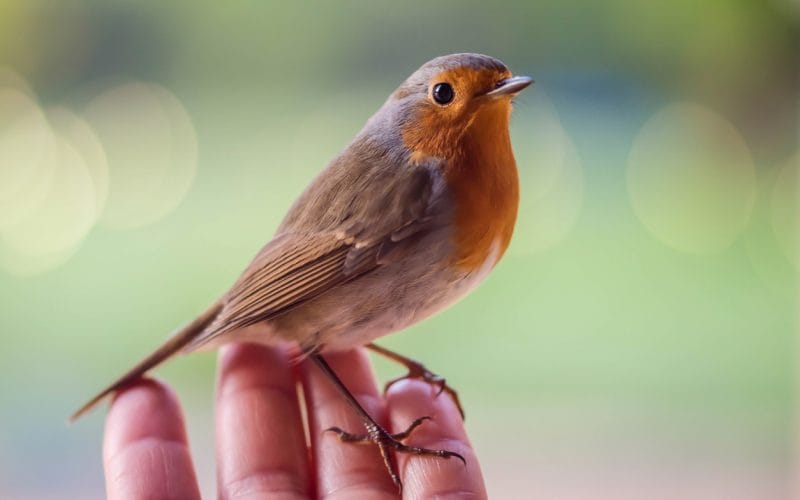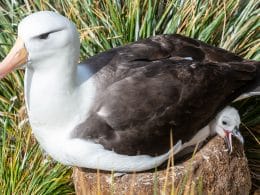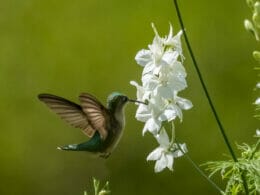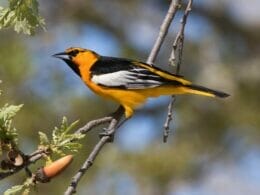You may not know if you’re new to birdwatching, but there are many bird species bearing shades of blue color on their bodies. Two of these are Bluebirds and Blue Jays.
Whether you’re a bird watcher or you’ve set up feeders in your yard, it can be tricky to tell apart these two birds from one another not only because of their similar names but also their similar features.
However, these are -in fact- two different birds and it’s not so difficult to differentiate between Bluebirds and Blue Jays once you know what to look for. Apart from sharing the blue color, the Bluebird vs Blue Jay comparison can be summed up as follows:


Author Note: Generally, Bluebirds are smaller thanBlueJjays and are more on the conservative and timid side. The song of Bluebirds also has a lower pitch and their sounds are not nearly as loud as those of Blue Jays.
While bluebirds prefer to stay passive and avoid confrontation so they’ll happily share territory and feed with other birds, Blue Jays are a lot more aggressive when it comes to securing their homes and chasing away other birds from food sources.
In the following Bluebird vs Blue Jay comparison, we take a closer look at the differences between these two fascinating birds.
Bluebird vs Blue Jay — Family and Classification
First things first, Bluebirds and Blue Jays belong to different families.
On one hand, bluebirds are part of the family Turdidae, which consists of more than 175 bird species including robins and thrushes. Species belonging to this family are commonly known as songbirds.
On the other hand, Blue Jays are part of the Corvidae family, which also consists of ravens, crows, magpies, and rooks. This family, In fact, consists of more than 120 species that are generally called corvids.
The Corvidae bird family is characterized by producing loud, harsh noises and demonstrating a somewhat social nature. Their plumage is usually vibrant and glossy but lacks sexual dimorphism.
This means that the feathers on both male and female blue jays possess the same color and size. Members of the Turdidae family, however, exhibit sexual dimorphism. As such, the female bluebird typically shows duller plumage than the male.
Bluebird vs Blue Jay — Physical Features
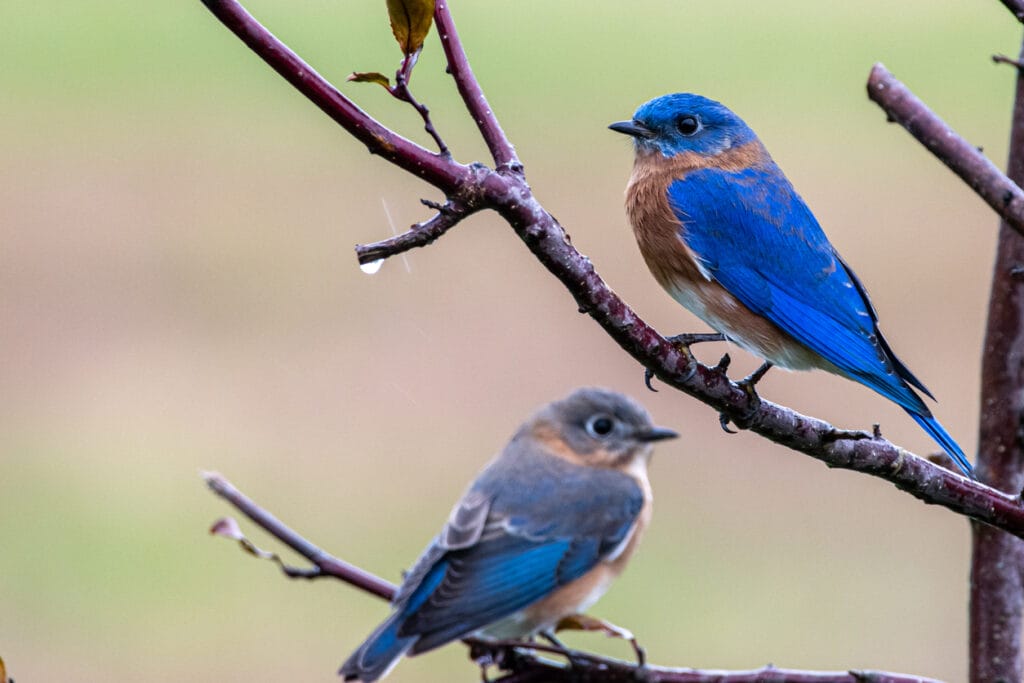
Now, let’s closely examine the physical features of the Bluebird vs Blue Jay, including the size, shape, and color of the birds.
Starting with the size, Bluebirds measure an average length between 6.5 to 8 inches. They have short, slim tails and -much like Blue Jays- blue heads and wings.
But unlike the Blue Jay, a large portion of the Bluebird’s breast is either orange or light brown whereas its undercarriage is normally white.
Also, the beaks on Bluebirds are a lot smaller than on Blue Jays, which is why their diet mainly consists of small bugs and fruit. Bluebirds have big rounded heads and short legs paired with sleek chests and plump bellies.
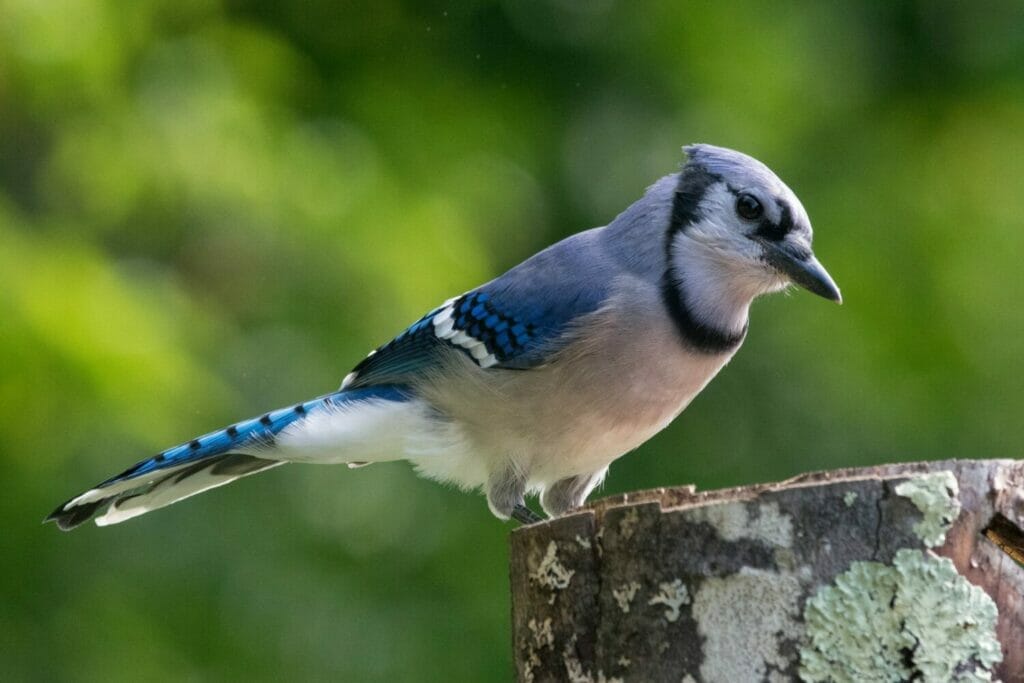
On the other hand, Blue Jays are significantly larger than Bluebirds, measuring around 10 to 12 inches long. Their tails are longer and wider and their legs are also longer than a Bluebird.
The wingspan of a Blue Jay can extend up to 16 inches. Their body shape is also a bit different than a Bluebird’s, with a thick neck connected to an ample chest.
Thanks to their bigger and stronger beaks, Blue Jays can feed on pretty much all types of seeds, nuts, and acorns.
The colors of a Blue Jay’s plumage are also more bright and striking coloring, featuring several shades of blue with black streaks on their tails, wings, and framing their faces. The undercarriage of a Blue Jay is white with no orange or brown hues, although some pale blue shading can occur.
Additionally, Blue Jays have a blue crest crowning their heads, which is a huge distinguishing feature that makes them unique from Bluebirds.
Blue Jays can raise and lower their crest; it’s usually up when the bird is being feisty, protecting its territory, as well as during courtship. When they’re relaxed, however, the crest remains flat.
Bluebird vs Blue Jay — Sounds and Songs
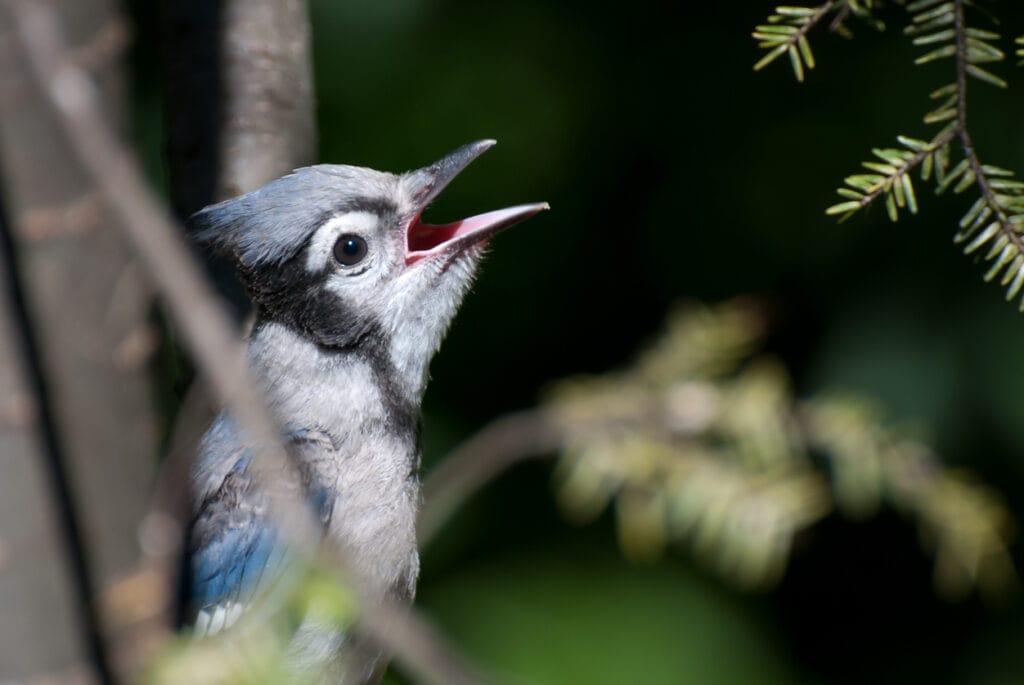
As members of the Corvidae family, Blue Jays are characterized by having quite an extensive range of sounds that they can generate. This includes whistled melodies, loud jeers, and even gurgling noises.
That said, the Blue Jay “song” is a lot quieter and lasts for up to 2 minutes. It consists of a series of whirrs, chucks, whines, clicks, and liquid notes.
Not to mention, Blue Jays are excellent imitators of sound and often mimic predators (such as hawks) to drive away other birds that compete with them over food. They can also mimic cats and even cellphone rings.
On the other hand, Bluebirds are way shyer with their sounds and song. The latter typically lasts for only 2 seconds and features a low-pitched warbling with a bunch of whistles and chattering mixed in.
Male Bluebirds may sometimes produce this song to catch the attention of a female. However, a softer version of the song is more commonly sung by males during nesting season.
Author Note: Female Bluebirds may also sing if a predator is spotted nearby.
Bluebird vs Blue Jay — Behavior
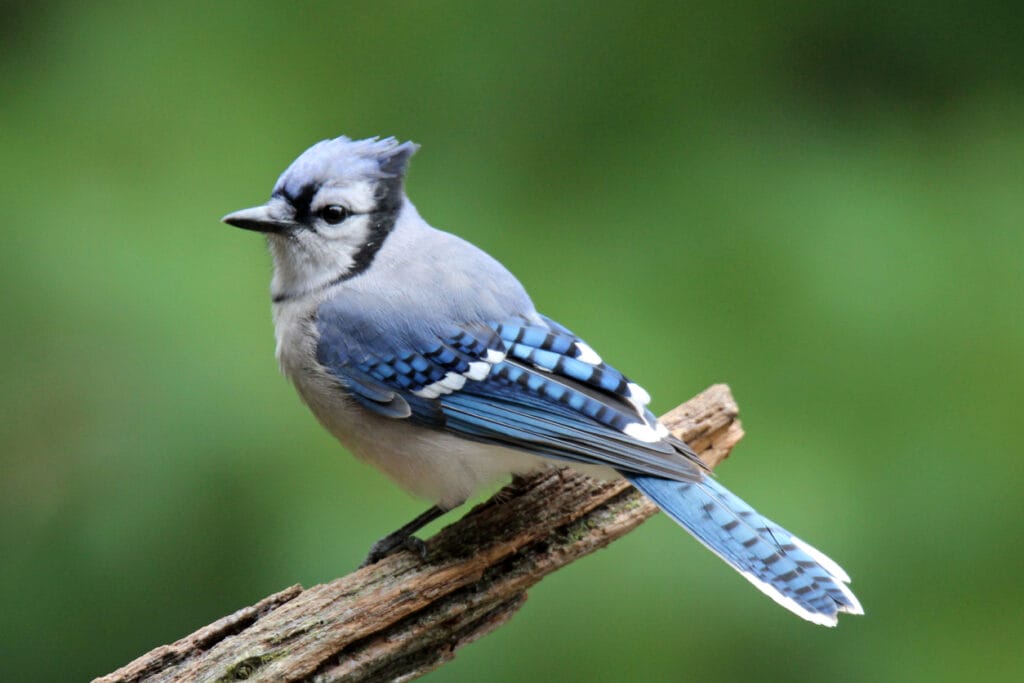
When it comes to behavior, there are multiple distinct differences between the two bird species.
For one, Bluebirds are known to have a more laid-back nature. They prefer solitude and usually perch in shrubs and trees in pairs, which helps them survey the area for bugs more thoroughly.
On the other hand, Blue Jays are “loud and proud” birds with smart and inquisitive tendencies. They’re also heaps more protective and territorial when it comes to their nests, having no issues engaging with any intruders even if that means diving at house pets or humans.
Author Note: When Blue Jays feel threatened, they’ll flare out their crest and produce loud, sharp calls. They’ll accompany that with quick beak snapping to deliver an aggressive display.
While Blue Jays don’t like other birds sharing their feeders and will chase them away to keep all the best bits for themselves, bluebirds avoid confrontation and prefer foraging for insects and seeds on the ground. for seeds and insects.
Bluebird vs Blue Jay — Habitat
As far as habitats go, Bluebirds like to stay in open fields and areas with scattered trees. These little birds also enjoy living around golf courses and urban trails.
On the other hand, Blue Jays prefer living in regions with many tall trees such as forests. Not to mention, they’re very adaptable so they don’t mind staying in urban areas given there are enough trees.
Although sometimes you can find Bluebirds and Blue Jays in the same areas, their main habitats are different. Bluebirds commonly reside in Nevada, New Mexico, Arizona, Texas, North Dakota, South Dakota, western Nebraska, western Kansas.
As for Blue Jays, they’re heavily present in Oregon, Idaho, Montana, Utah, and Washington.
Bluebird vs Blue Jay — Nesting Preferences
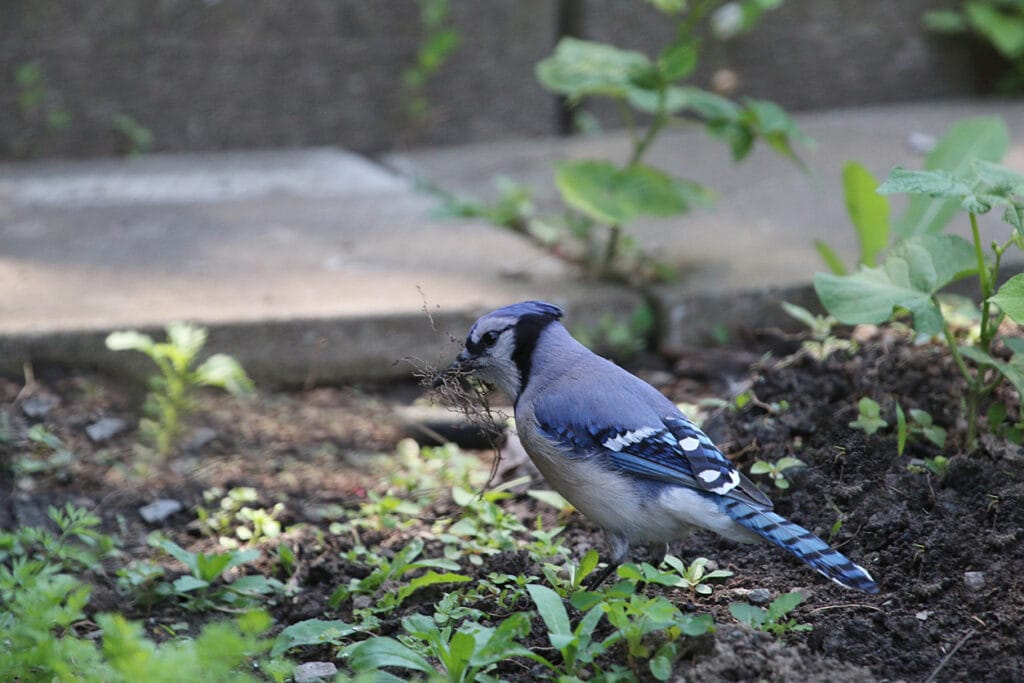
The nesting preferences of Bluebirds and Blue Jays are very different.
On one hand, Bluebirds favor cavities when it comes to building nests. They line them with grass, pine needles, small twigs, and other nesting elements.
They’re also open to using nesting boxes if you put them out in your yard. In this case, leave the boxes out throughout the whole year because bluebirds often rely on them for shelter during cold weather.
Blue Jays, however, prefer nesting in trees, particularly in the forks where the trunk and the branches meet. They also like elevation, building nests up to 20 feet high.
Male and female Blue Jays join efforts to create cup-shaped nests using grass, bark, sticks, and moss. If you’re trying to make your yard hospitable for Blue Jays, you should set up a nesting platform of a minimum area of 8 square inches.
Top Tip: For the best results, erect this platform on the fork of a mature tree.
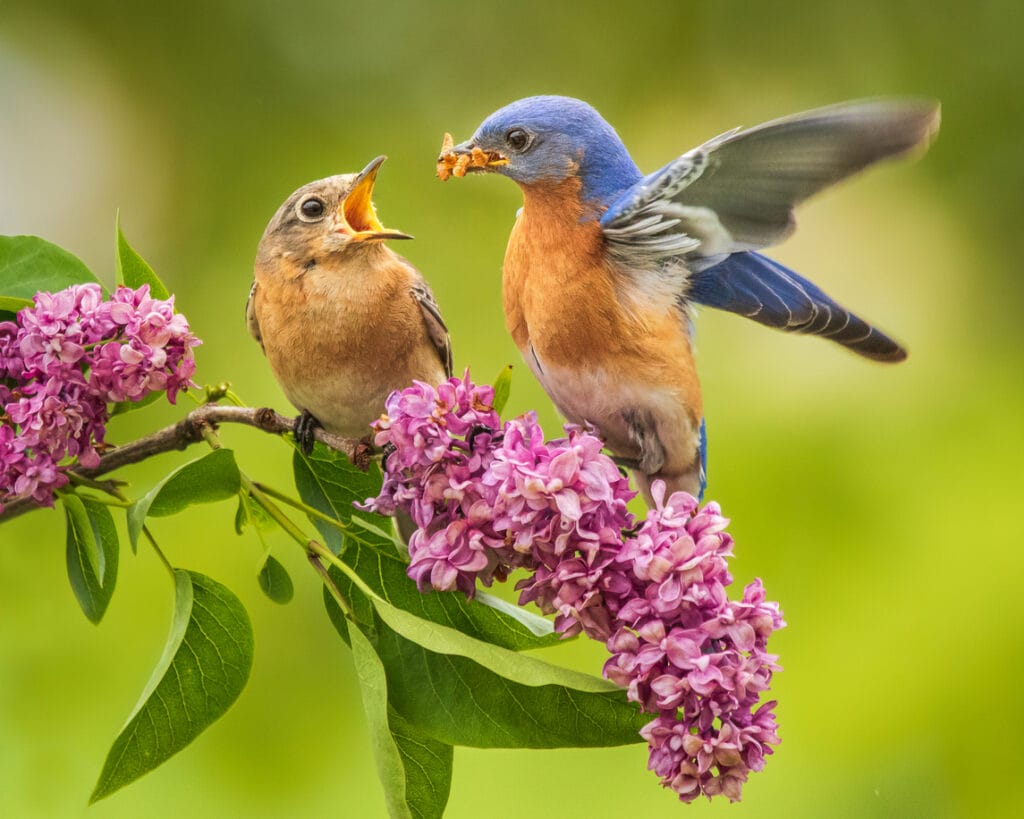
Bluebird vs Blue Jay — Food Preferences
If you’re looking to attract Bluebirds and Blue Jays to your yard, you should know what type of food to offer as each species prefers different sorts of food.
For example, Bluebirds enjoy munching on suet and mealworms. So, you should provide these on feeders near the ground or on platform feeders.
To lure in Blue Jays, offer them peanuts, sunflower seeds, suet, and corn. Be sure to put these on a platform feeder with enough room for a jay to rest and hop around.
Wrap Up
There you have it, a complete Bluebird vs Blue Jay comparison to help you tell them apart the next time you encounter one of these blue beauties.
Generally, Bluebirds are smaller, quieter, and more timid. Their song also has a lower pitch and continues for a much shorter time.
While Bluebirds prefer to stay passive and don’t mind sharing territory and food with other birds, Blue Jays are way more aggressive. They’ll strongly protect their homes and chase away other birds from feeders.
FAQ
The Blue Jay belongs to the Corvid family and its relatives are ravens, rooks, jackdaws, crows and magpies.
There are three species of Bluebird – the Mountain, Eastern and Western. They are thrushes and belong to the Turdidae family.
There is no definitive answer to that question but it would seem to make sense that it is named after its vibrant coloring.





